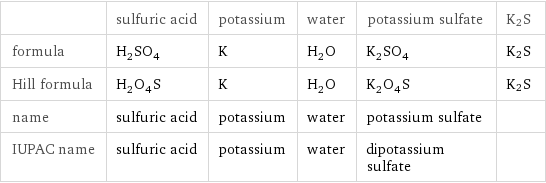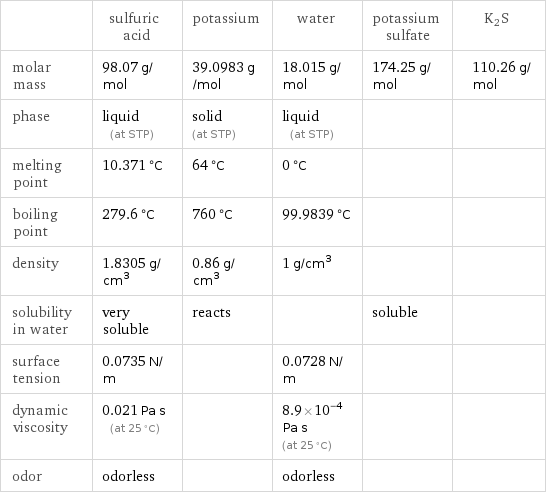Input interpretation

H_2SO_4 sulfuric acid + K potassium ⟶ H_2O water + K_2SO_4 potassium sulfate + K2S
Balanced equation

Balance the chemical equation algebraically: H_2SO_4 + K ⟶ H_2O + K_2SO_4 + K2S Add stoichiometric coefficients, c_i, to the reactants and products: c_1 H_2SO_4 + c_2 K ⟶ c_3 H_2O + c_4 K_2SO_4 + c_5 K2S Set the number of atoms in the reactants equal to the number of atoms in the products for H, O, S and K: H: | 2 c_1 = 2 c_3 O: | 4 c_1 = c_3 + 4 c_4 S: | c_1 = c_4 + c_5 K: | c_2 = 2 c_4 + 2 c_5 Since the coefficients are relative quantities and underdetermined, choose a coefficient to set arbitrarily. To keep the coefficients small, the arbitrary value is ordinarily one. For instance, set c_5 = 1 and solve the system of equations for the remaining coefficients: c_1 = 4 c_2 = 8 c_3 = 4 c_4 = 3 c_5 = 1 Substitute the coefficients into the chemical reaction to obtain the balanced equation: Answer: | | 4 H_2SO_4 + 8 K ⟶ 4 H_2O + 3 K_2SO_4 + K2S
Structures

+ ⟶ + + K2S
Names

sulfuric acid + potassium ⟶ water + potassium sulfate + K2S
Equilibrium constant
![Construct the equilibrium constant, K, expression for: H_2SO_4 + K ⟶ H_2O + K_2SO_4 + K2S Plan: • Balance the chemical equation. • Determine the stoichiometric numbers. • Assemble the activity expression for each chemical species. • Use the activity expressions to build the equilibrium constant expression. Write the balanced chemical equation: 4 H_2SO_4 + 8 K ⟶ 4 H_2O + 3 K_2SO_4 + K2S Assign stoichiometric numbers, ν_i, using the stoichiometric coefficients, c_i, from the balanced chemical equation in the following manner: ν_i = -c_i for reactants and ν_i = c_i for products: chemical species | c_i | ν_i H_2SO_4 | 4 | -4 K | 8 | -8 H_2O | 4 | 4 K_2SO_4 | 3 | 3 K2S | 1 | 1 Assemble the activity expressions accounting for the state of matter and ν_i: chemical species | c_i | ν_i | activity expression H_2SO_4 | 4 | -4 | ([H2SO4])^(-4) K | 8 | -8 | ([K])^(-8) H_2O | 4 | 4 | ([H2O])^4 K_2SO_4 | 3 | 3 | ([K2SO4])^3 K2S | 1 | 1 | [K2S] The equilibrium constant symbol in the concentration basis is: K_c Mulitply the activity expressions to arrive at the K_c expression: Answer: | | K_c = ([H2SO4])^(-4) ([K])^(-8) ([H2O])^4 ([K2SO4])^3 [K2S] = (([H2O])^4 ([K2SO4])^3 [K2S])/(([H2SO4])^4 ([K])^8)](../image_source/35c5399d385a3ee4d5d7d2bf2b8e9a24.png)
Construct the equilibrium constant, K, expression for: H_2SO_4 + K ⟶ H_2O + K_2SO_4 + K2S Plan: • Balance the chemical equation. • Determine the stoichiometric numbers. • Assemble the activity expression for each chemical species. • Use the activity expressions to build the equilibrium constant expression. Write the balanced chemical equation: 4 H_2SO_4 + 8 K ⟶ 4 H_2O + 3 K_2SO_4 + K2S Assign stoichiometric numbers, ν_i, using the stoichiometric coefficients, c_i, from the balanced chemical equation in the following manner: ν_i = -c_i for reactants and ν_i = c_i for products: chemical species | c_i | ν_i H_2SO_4 | 4 | -4 K | 8 | -8 H_2O | 4 | 4 K_2SO_4 | 3 | 3 K2S | 1 | 1 Assemble the activity expressions accounting for the state of matter and ν_i: chemical species | c_i | ν_i | activity expression H_2SO_4 | 4 | -4 | ([H2SO4])^(-4) K | 8 | -8 | ([K])^(-8) H_2O | 4 | 4 | ([H2O])^4 K_2SO_4 | 3 | 3 | ([K2SO4])^3 K2S | 1 | 1 | [K2S] The equilibrium constant symbol in the concentration basis is: K_c Mulitply the activity expressions to arrive at the K_c expression: Answer: | | K_c = ([H2SO4])^(-4) ([K])^(-8) ([H2O])^4 ([K2SO4])^3 [K2S] = (([H2O])^4 ([K2SO4])^3 [K2S])/(([H2SO4])^4 ([K])^8)
Rate of reaction
![Construct the rate of reaction expression for: H_2SO_4 + K ⟶ H_2O + K_2SO_4 + K2S Plan: • Balance the chemical equation. • Determine the stoichiometric numbers. • Assemble the rate term for each chemical species. • Write the rate of reaction expression. Write the balanced chemical equation: 4 H_2SO_4 + 8 K ⟶ 4 H_2O + 3 K_2SO_4 + K2S Assign stoichiometric numbers, ν_i, using the stoichiometric coefficients, c_i, from the balanced chemical equation in the following manner: ν_i = -c_i for reactants and ν_i = c_i for products: chemical species | c_i | ν_i H_2SO_4 | 4 | -4 K | 8 | -8 H_2O | 4 | 4 K_2SO_4 | 3 | 3 K2S | 1 | 1 The rate term for each chemical species, B_i, is 1/ν_i(Δ[B_i])/(Δt) where [B_i] is the amount concentration and t is time: chemical species | c_i | ν_i | rate term H_2SO_4 | 4 | -4 | -1/4 (Δ[H2SO4])/(Δt) K | 8 | -8 | -1/8 (Δ[K])/(Δt) H_2O | 4 | 4 | 1/4 (Δ[H2O])/(Δt) K_2SO_4 | 3 | 3 | 1/3 (Δ[K2SO4])/(Δt) K2S | 1 | 1 | (Δ[K2S])/(Δt) (for infinitesimal rate of change, replace Δ with d) Set the rate terms equal to each other to arrive at the rate expression: Answer: | | rate = -1/4 (Δ[H2SO4])/(Δt) = -1/8 (Δ[K])/(Δt) = 1/4 (Δ[H2O])/(Δt) = 1/3 (Δ[K2SO4])/(Δt) = (Δ[K2S])/(Δt) (assuming constant volume and no accumulation of intermediates or side products)](../image_source/95f7c5c83fe4d4fca57c8185e730723e.png)
Construct the rate of reaction expression for: H_2SO_4 + K ⟶ H_2O + K_2SO_4 + K2S Plan: • Balance the chemical equation. • Determine the stoichiometric numbers. • Assemble the rate term for each chemical species. • Write the rate of reaction expression. Write the balanced chemical equation: 4 H_2SO_4 + 8 K ⟶ 4 H_2O + 3 K_2SO_4 + K2S Assign stoichiometric numbers, ν_i, using the stoichiometric coefficients, c_i, from the balanced chemical equation in the following manner: ν_i = -c_i for reactants and ν_i = c_i for products: chemical species | c_i | ν_i H_2SO_4 | 4 | -4 K | 8 | -8 H_2O | 4 | 4 K_2SO_4 | 3 | 3 K2S | 1 | 1 The rate term for each chemical species, B_i, is 1/ν_i(Δ[B_i])/(Δt) where [B_i] is the amount concentration and t is time: chemical species | c_i | ν_i | rate term H_2SO_4 | 4 | -4 | -1/4 (Δ[H2SO4])/(Δt) K | 8 | -8 | -1/8 (Δ[K])/(Δt) H_2O | 4 | 4 | 1/4 (Δ[H2O])/(Δt) K_2SO_4 | 3 | 3 | 1/3 (Δ[K2SO4])/(Δt) K2S | 1 | 1 | (Δ[K2S])/(Δt) (for infinitesimal rate of change, replace Δ with d) Set the rate terms equal to each other to arrive at the rate expression: Answer: | | rate = -1/4 (Δ[H2SO4])/(Δt) = -1/8 (Δ[K])/(Δt) = 1/4 (Δ[H2O])/(Δt) = 1/3 (Δ[K2SO4])/(Δt) = (Δ[K2S])/(Δt) (assuming constant volume and no accumulation of intermediates or side products)
Chemical names and formulas

| sulfuric acid | potassium | water | potassium sulfate | K2S formula | H_2SO_4 | K | H_2O | K_2SO_4 | K2S Hill formula | H_2O_4S | K | H_2O | K_2O_4S | K2S name | sulfuric acid | potassium | water | potassium sulfate | IUPAC name | sulfuric acid | potassium | water | dipotassium sulfate |
Substance properties

| sulfuric acid | potassium | water | potassium sulfate | K2S molar mass | 98.07 g/mol | 39.0983 g/mol | 18.015 g/mol | 174.25 g/mol | 110.26 g/mol phase | liquid (at STP) | solid (at STP) | liquid (at STP) | | melting point | 10.371 °C | 64 °C | 0 °C | | boiling point | 279.6 °C | 760 °C | 99.9839 °C | | density | 1.8305 g/cm^3 | 0.86 g/cm^3 | 1 g/cm^3 | | solubility in water | very soluble | reacts | | soluble | surface tension | 0.0735 N/m | | 0.0728 N/m | | dynamic viscosity | 0.021 Pa s (at 25 °C) | | 8.9×10^-4 Pa s (at 25 °C) | | odor | odorless | | odorless | |
Units
